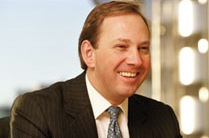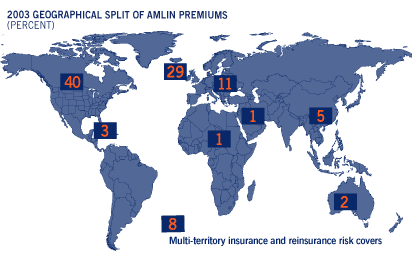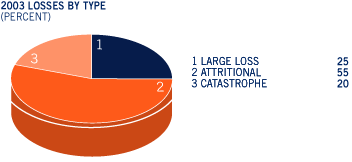|
 |
|
|
 |
|
|
 |

|
|
For the last four years our primary strategy has been to create
value by building Amlin to become a leading insurer in
the London Market, recognised by insureds and insurance
brokers as a first choice for leading risks in our chosen
fields of expertise. In so doing our aim has been to
achieve returns for our shareholders over the insurance
cycle that are superior to our peers.
CHARLES PHILIPPS
CHIEF EXECUTIVE

|
|
|
 |
|
CHIEF EXECUTIVE’S STRATEGY REVIEW
Capacity and long term growth
Amlin is now a fully integrated Lloyd’s business, underwriting
100% of Syndicate 2001’s capacity for 2004. The take-up of
the remaining third party capacity by Amlin for 2004 results in
a 16% increase in our headline owned capacity; further good
growth at a time when margins are exceptionally strong.
We have maintained Syndicate 2001’s capacity at £1 billion
for 2004 but we have not renewed the quota share reinsurance
arrangement we had in place for 2002 and 2003 for up to
£100 million. This reflects our desire, with insurance rates
generally reaching a peak, to focus on maintaining margins rather
than chasing volumes. We are pleased that the Lloyd’s overall
capacity has been similarly restrained. In line with our policy of
maintaining a gross underwriting discipline, we will reduce our
capacity if competitive forces prevent us from charging what we
consider to be the right technical price for risks.
As the largest integrated Lloyd’s business, our size is another of
Amlin’s core advantages. In addition to a robust market position
that size entails, it provides for a sound risk management
proposition where we can contain our largest line sizes to modest
percentages of capacity.
Gross premium, for our continuing business, increased by 97%
from its peak in the last hard market to current levels. Our aim
is to double the business from one cycle to another, recognising
that between peaks we intend to reduce capacity if underwriting
conditions limit the prospects for achieving an acceptable margin.
Back to top

Diversity
We aim to maintain one of Amlin’s core strengths, being its
diversity both by class of business and geographically. Underwriting
some 32 specialised business classes, we have a diverse spread of
risk and the ability to vary the mix of business with a view to
optimising risk based returns, according to the specific market
conditions for each class.
55% of our gross written premium in 2003 comes from business
that is attritional in nature and the returns anticipated from
these, especially in today’s underwriting markets, act as a good
counterbalance to the more volatile classes, such as property
reinsurance and airline insurance, which have the potential for
significantly higher returns. The benefit of this balance of risk
was clearly demonstrated by our overall underwriting year profit
of £6.3 million for 2001, after reserving for a loss equivalent to
£70.7 million from the 11 September 2001 terrorist losses.
We have increased our short-tail focus since we restructured and cut
back our long-tail business in the late 1990’s and 2000. By keeping
long-tail business below around 15% of our total income, we believe
we can benefit from risk diversification and strong liability markets
while limiting the potential for adverse reserve development, which
is today causing a material problem to so many in the industry.
We regularly review the current and long term business case for
each of our classes of business. During 2003 we continued
to grow those areas where rates had reached excellent levels
in 2002, such as catastrophe reinsurance and direct property
insurance. In addition, we also grew classes which were still
attracting good rate rises including liability, and some marine
classes such as hull and yacht insurance. We also decided to
reposition our bloodstock account so that it became more diverse
and attritional in nature, and recruited a new underwriter to help
achieve this.

Branding
Recognising the significantly stronger reputation and position that
we now enjoy in the London market, we believe the time is right
for each of Amlin’s principal businesses to trade as Amlin rather
than under their historic names. Soundings taken with our major
broking partners indicated that both they and clients would prefer
this simplification and that it will help ensure we punch our full
weight in the marketplace. We are fortunate in having successfully
integrated the strengths and good practices of these franchises
into the wider Amlin.
Capital and our return on equity (ROE) focus
Since our equity capital issuance in 2002, one of our goals has
been to achieve an average annual after tax return on equity over
a full cycle, of in excess of 15%. Our 2002 and 2003 return on
equity, of 20% and 27% respectively, together with a continued
positive outlook, places us in a good position to achieve this.
Our focus on ROE has involved gearing the balance sheet with the
use of letters of credit (LOC). Our diversity and risk management
have enabled us to do this without over-exposing the business to
significant loss. The healthy returns now being earned, which will
result in strong free cash flow from 2005, are expected to more
than extinguish the need for LOC finance by the time industry
margins become questionable. Additionally, it will support the
dividend policy referred to in the Chairman’s Statement and allow
retention of sufficient funds to invest in the business.
|
|
|
|
|
|